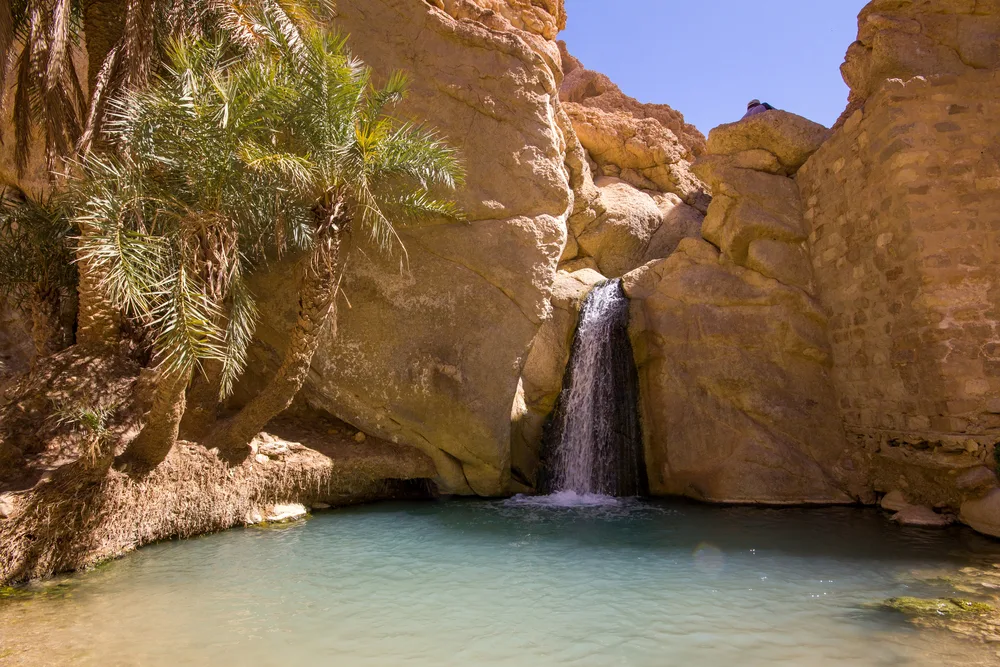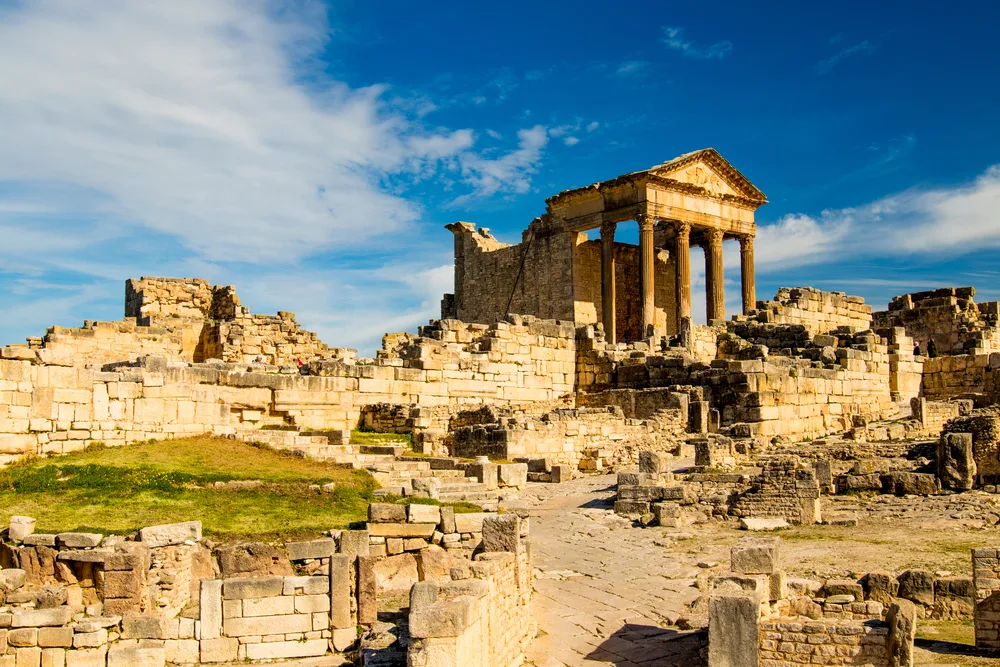What's the best time to visit Tunisia?
The best time to visit Tunisia is between April and June, when you can enjoy mild weather and minimal rain, ideal for beaches and sightseeing. This period is less crowded, providing a more peaceful experience, and hotel rates are budget-friendly, ranging from $31 to $89 per night. Moderate rainfall during these months also adds to the charm of the country, compared to the dry summer season.
Tunisia is a magical place to visit, but if you want the top-tier experience, you should know the right time to go. The best time to visit Tunisia really depends on your goals and plans for the trip.
Are you planning for the best overall Tunisia experience? The most budget-friendly travel dates? Or the time of year with the fewest crowds?
Don’t worry — you’re in the right place. We’ll show you the best, least busy, cheapest, and worst times to visit this storied country; let us be your guide!
The Overall Best Time to Visit Tunisia

Romas_Photo/Shutterstock
The overall best time to visit Tunisia is from April to June. During this time, you’ll experience mild, warm weather with little rain that makes for incredible beach days and sightseeing.
Between April and June, you’ll be able to experience the absolute best Tunisia has to offer outdoors. That makes for a better experience no matter what your plans are for the trip!
Heading to the beaches along the coast, sightseeing throughout the country, or hitting up markets and souks in the cities are all better in 71F-87F weather with just enough rain to keep things flourishing.
You’ll see anywhere from 1.6″ (April) to 0.5″ (June) of rain over a 30-day period during this time, making it much more enjoyable than the dryer, hotter summer. Best of all, Tunisia is much quieter and less crowded during the spring shoulder season – the tourists won’t start arriving en masse until July, August, and September.
That means rates on hotels will be cheaper, you’ll have better luck bartering and making your way through the markets, and find more availability for flights and accommodations.
Expect hotels to cost anywhere from $31-$82/night in April and May and $34-$89/night in June. Overall, the best season to visit turns out to be one of the most affordable, too!
Cheapest Time to Visit Tunisia

Karina Bostanika/Shutterstock
The cheapest time to visit Tunisia is during the winter months of November to January. Hotel rates hit their lowest point during this time of year.
Tunisia is never a very expensive place to visit – aside from the cost of getting there, hotel rates and daily cost of living is quite low. But if you’re interested in visiting during the cheapest time, November to January is it!
From November through January, hotel rate averages drop to around $29-$75/night. That’s even lower than the best time to visit (the spring shoulder season) when rates start around $31/night and go up to $82/night.
Since the cost difference isn’t huge between the best months to visit and the cheapest, you might find that you’re willing to spend a few dollars more per night to go when the weather is at its best.
But the weather from November to January isn’t terrible. With moderate highs ranging from 61F in January to 70F in November, you might be chilly, but you won’t be cold.
It rains more during this time of year, with different areas of Tunisia receiving anywhere from 2-2.7 inches of rain each month. Still, most days are clear and you’ll find plenty of time to get outside and enjoy the sunshine.
Lively festivals and craft fairs, museums, galleries, desert tours, and markets make excellent things to do during the November-January time period.
Least Busy Time to Visit Tunisia

Sergii Nagornyi/Shutterstock
The least busy time to visit Tunisia is from October to December, possibly because the weather is cooler and there’s more rainfall than the rest of the year.
It’s really a shame that people don’t come to Tunisia more during the fall and early winter, because it’s actually a nice time to go! Take advantage of the smaller crowds and come to enjoy the country during the low season.
Imagine moderate weather with temperatures ranging from 63F (December) to 79F (October) along with some rainfall and plenty of clear days.
December gets the most rain in Tunisia, averaging around 2.7″ during the month. October gets around 2.2″ of rain, while November sees roughly 2″.
The decrease in visitors from October to December also means a drop in hotel rates. Expect to pay somewhere between $29-$82/night, depending on where you stay and the quality of your hotel.
Worst Time to Visit Tunisia

Anton Boldak/Shutterstock
The worst time to visit Tunisia is July and August, when the daily highs peak around 93F and there’s little to no rain to cool things off. It’s the peak tourism season, so crowds are unavoidable.
July and August are the worst time to go to Tunisia because you’re getting the hottest weather, the biggest crowds, and the highest prices.
Since this is the peak of the busy season in Tunisia, tourists descend on the country and flood into the capital and popular landmarks, museums, galleries, and markets.
Hotels know that rooms are in high demand this time of year, so prices are raised to meet the demand. You may find higher prices at restaurants, markets, and shops in Tunisia, too.
The hot temperatures may not be a big deal if you’re planning to visit the beach – after all, hot days with lots of sunshine are part of the ideal beach trip – but it makes sightseeing and city exploration difficult.
On top of the heat and crowds, you may run into problems with finding vacancies at hotels during this time of year. Things can book up quickly during the busy season!
Things to Consider

Adisa/Shutterstock
Traveling to Tunisia guarantees a once-in-a-lifetime experience, especially if you’re able to go during the best time to visit! Here are some helpful travel tips that can make the most of your stay.
- Heed current travel advisories. Tunisia is under a level 2 travel advisory from the U.S. Department of State right now due to an increase in terrorist activity and terrorist groups operating along the borders and in mountainous and desert regions. The most dangerous areas are under a level 4 “Do not travel” advisory and include Libyan and Algerian borders, western mountains, desert zones south of Remada, and central Tunisia in Sidi Bou Zid.
- Understand the Islamic customs. Tunisia is 99% Muslim and travelers will need to respect and follow some customs to avoid issues here. Bikinis and beachwear are fine for tourists, but only on the beach. Modest dress is expected for women with no low-cut tops, tank tops, or short shorts. Avoid taking photos of government or military sites here. Same-sex couples shouldn’t travel to Tunisia, where LGBT relationships are illegal.
- Don’t drink tap water. Much of Tunisia has access to purified water, but it’s possible to get sick with a waterborne disease when drinking tap water here (and in many other places). It’s best to drink bottled water during your stay to reduce your risk of getting sick.
- Prepare for restroom differences. Many bathrooms in Tunisia won’t be equipped with toilet paper, as it’s not commonly used by locals. Wash basins and bidets are much more common. Bring wet wipes if you think you’ll have trouble adapting! You may also come across older-style squat toilets while in Tunisia that require you to squat to the floor.
Frequently Asked Questions

Local market or souks in Tunis, Tunisia November 2019/Alex Cimbal/Shutterstock
Still have a few questions about narrowing down the best time to visit Tunisia? Have a look at the most frequently asked questions to learn more.
What is the best month to go to Tunisia?
May is the best month to go to Tunisia overall. With daily highs around 80F, roughly an inch of rain throughout the month, and 14 hours of warm sunshine each day, May makes for an incredible Tunisian visit.
Fewer people come to Tunisia in May as it’s just before the peak summer season. Hotel rates in May are affordable and range from $31-$82/night, according to Google Hotels.
Is there a rainy season in Tunisia?
Tunisia experiences a rainy season from September to April, but it’s still a relatively dry climate and doesn’t receive a ton of rain during this time.
Rains are heaviest from October to February, which see anywhere from 2” (November) to 2.7” (December).
Is February a good time to visit Tunisia?
February can be a good time to visit Tunisia, but it’s a bit rainy and cool. Temperatures peak around 62F with lows in the 40s and around 2.2” of rain. There are around 11 hours of sunshine each day.
The months of April, May, or June would be better options if you’re looking for warmer weather, more sunshine hours, and less rainfall.
How warm is Tunisia in March?
Tunisia is somewhat warm in March. The country sees average daily highs around 66F with lows around 48F in March. There’s some rainfall (around 1.8”), but Tunisia is nearing the end of the rainy season by this time.
So, What’s the Best Time to Visit Tunisia?
Tunisia is best experienced from April to June, just before the hot and busy summer hits. Temperatures are warm, more so in June, and there’s little rainfall to get in the way of plans.
Head to Tunisia between November and January if you want to save a little money on your trip. Hotel rates are at their lowest during this slower time of year.
From October to December, you’ll find the fewest crowds in Tunisia. The cooler weather and increased rainfall helps keep tourists away. Try to avoid planning your visit in July or August – the hottest, driest months of the year here and the peak of the busy season.
From colorful markets to amazing Ottoman architecture and historic sites, Tunisia is an African wonder that world travelers will be privileged to experience.
Keep travel advisories and safety first in your mind as you think about planning a trip here – Tunisia is incredible, but there are some areas tourists should steer clear of for now!



